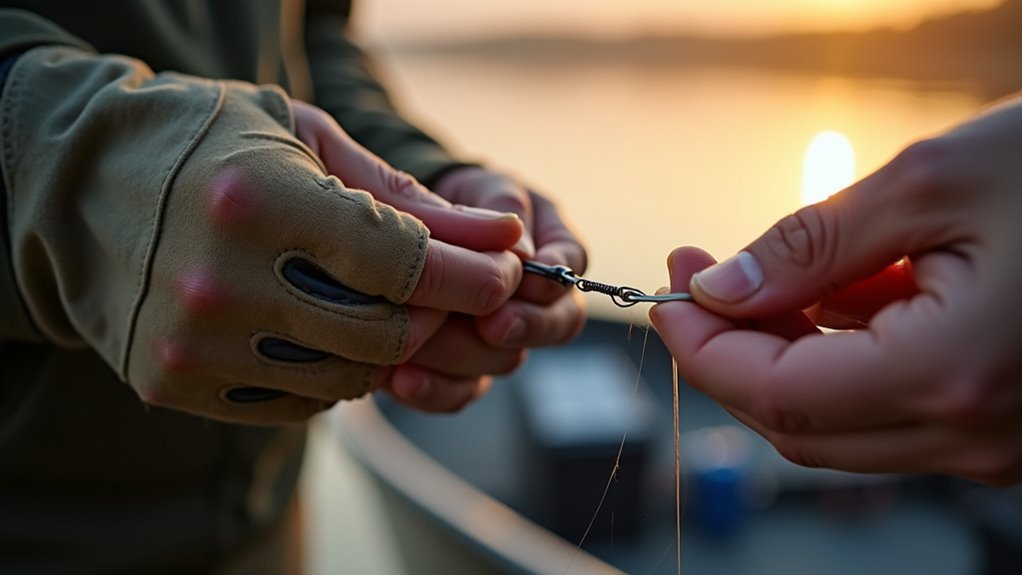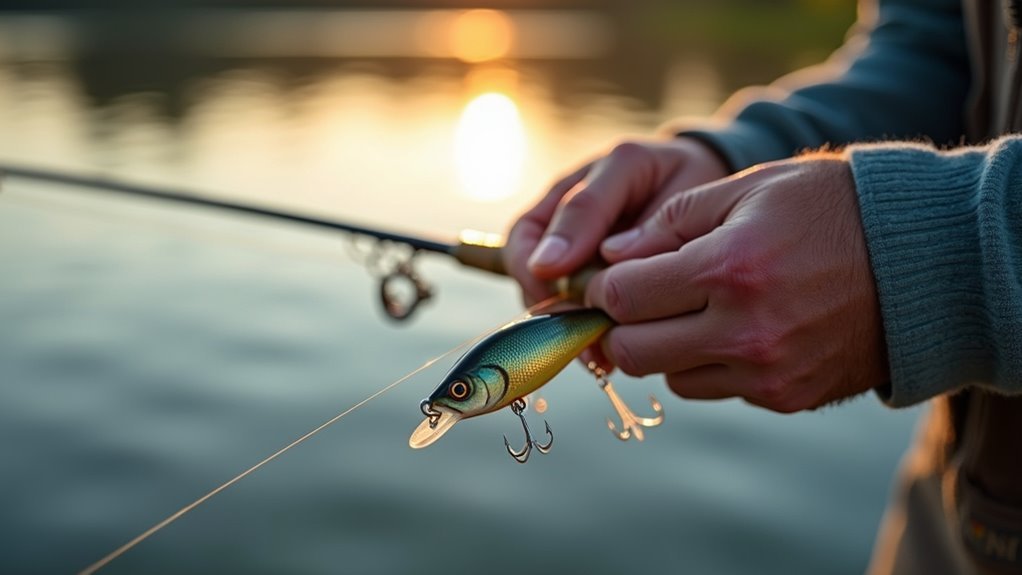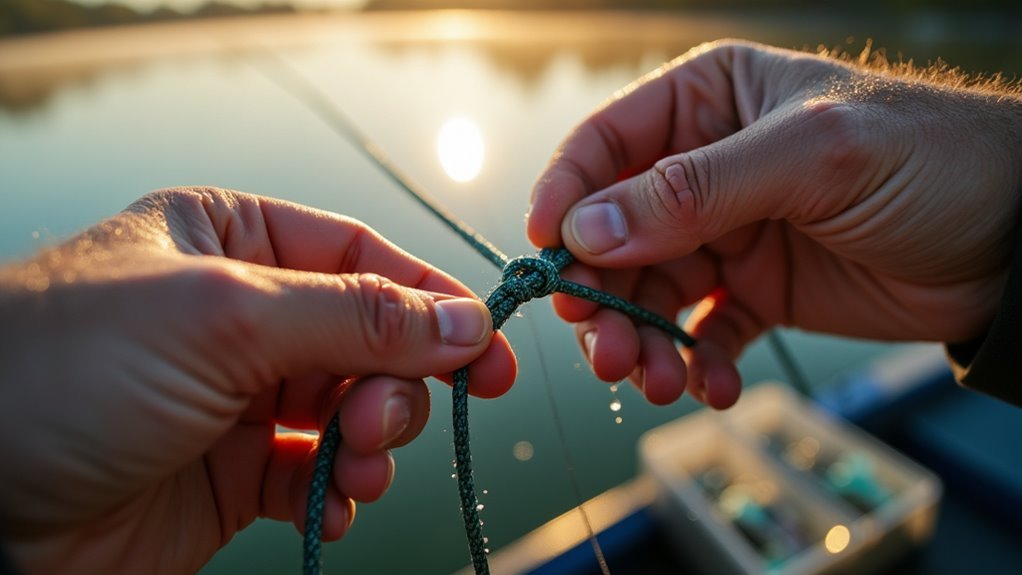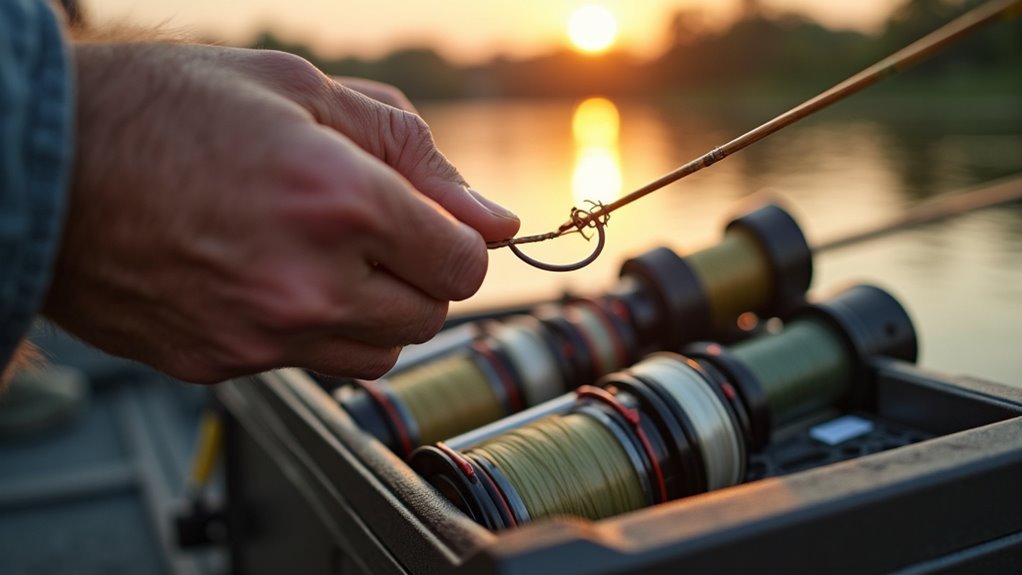We’ve found that mastering five essential knots can dramatically improve your bass fishing success. The Palomar is your strongest all-purpose connection, while the Improved Clinch works great for medium-sized lures. Loop knots give your baits more natural movement, and the Albright connects different line types seamlessly. Don’t overlook the San Diego Jam knot – it’s a tuna fishing secret that works wonders for trophy bass. These knot skills might just be what separates you from landing that monster lurking below.
The Palomar Knot: Your Go-To Fishing Connection

When it comes to bass fishing, your connection to the fish begins with a single knot. The Palomar is our absolute favorite for a reason—it’s widely regarded as the strongest knot in fishing. We’ve tied thousands of these in all conditions, from sunny afternoons to pitch-black mornings.
What makes it special? It retains nearly all your line’s strength and works beautifully with braided lines. Even with cold fingers or in low light, you can master this simple tie. We’ve landed trophy bass that would’ve snapped lesser knots—that’s why it’s on every serious angler’s must-know list.
Mastering the Improved Clinch Knot for Bass Fishing

While the Palomar knot earns our top spot, the Improved Clinch Knot deserves a prime position in every bass angler’s arsenal. We’ve relied on this trusty connection (also called the Salmon knot) for decades, especially when rigging lighter tackle.
| Feature | Benefit | Best Used With |
|---|---|---|
| Extra final tuck | Enhanced holding power | Medium-sized hooks |
| Simple to tie | Quick rigging on the water | Lures under 1/4 oz |
| Reliable strength | Fewer lost fish | Lines under 30lb test |
Remember to lubricate before tightening to prevent friction burn. We’ve landed countless smallmouth using this knot when fishing clear northern lakes.
Loop Knots: Maximizing Lure Action and Movement

Unlike standard knots that secure your lure tightly to the line, loop knots create a small circle of line that allows your bait to move more naturally in the water. We’ve seen countless big bass strike lures tied with loop knots when they wouldn’t touch the same bait with a standard connection.
- Enhances side-to-side wobble on crankbaits
- Creates more lifelike presentation for soft plastics
- Reduces line twist with topwater lures
- Works especially well in clear water when fish are finicky
The Non-Slip Loop Knot is our go-to choice here—it’s strong, simple, and won’t come undone when a trophy bass strikes.
Connecting Different Lines: When and How to Use the Albright Knot

The Albright Knot solves one of the biggest challenges bass anglers face—connecting two different types of fishing line together. We’ve all been there, wanting the sensitivity of braid with the invisibility of fluorocarbon near our lure.
This knot shines when joining lines of unequal diameter, like attaching that heavy braided main line to a fluorocarbon leader. We’ve used it countless times in murky reservoirs where bass are line-shy but structure is thick.
Form a loop in your heavier line, pass the thinner line through, wrap it back, and you’ve got a connection that won’t fail when that trophy strikes.
Choosing the Right Knot for Your Fishing Line Type

Each fishing line in your tackle box demands its own perfect knot partner for maximum performance. We’ve learned this lesson after countless days on the water, watching great fish swim away with our favorite lures when knots failed.
Matching the right knot to your line is the difference between trophy photos and the one that got away.
- Braided lines need Palomar or FG knots to prevent slippage
- Monofilament works best with Improved Clinch or Trilene knots
- Fluorocarbon requires San Diego Jam or Uni knots for strength
- When connecting different line types, trust the Albright knot
San Diego Jam Knot: The Tuna Fisher’s Secret for Bass
Originally developed for battling monster tuna in the Pacific, the San Diego Jam Knot has become our secret weapon for bass fishing in freshwater lakes across America. We’ve found it retains an impressive amount of line strength—better than many other knots we’ve tied over the years.
What makes this knot special is its versatility. Whether you’re using braided, monofilament, or fluorocarbon lines, the San Diego Jam performs brilliantly. Last summer at Lake Okeechobee, this knot saved us when a 7-pound largemouth hit our crankbait—not a single slip!
Frequently Asked Questions
How Long Do Fishing Knots Typically Last Before Needing Retying?
We should check our fishing knots after each outing. They typically last one fishing trip, but can degrade faster due to abrasion, sunlight, water exposure, and fighting fish. Inspect them regularly.
Can Weather Conditions Affect Knot Strength and Reliability?
Yes, weather conditions definitely affect our knots. We’ll see reduced strength in wet, frozen, or sun-damaged lines. Extreme heat can weaken knots, while cold makes them stiff. Always check our knots in changing conditions.
Which Knots Work Best With Circle Hooks for Bass?
Quick as lightning, we’ve found circle hooks work best with Snell or Palomar knots. They maintain the hook’s natural angle, ensuring proper hook sets. The San Diego Jam knot’s also reliable for larger bass.
How Do Fishing Knots Perform in Saltwater Versus Freshwater?
We’ve found that in saltwater, knots face more corrosion and need extra maintenance. Freshwater knots generally last longer, but in both environments, we recommend checking knots regularly for wear and tear.
What’s the Fastest Knot to Tie in Emergency Situations?
Like a rapid-fire lifeline, the Improved Clinch Knot’s our emergency go-to. We’d recommend mastering this knot when seconds count—it’s quick to tie, reliable under pressure, and works well in both salt and freshwater conditions.
Conclusion
We’ve all been there—fighting the bass of a lifetime while silently praying our knots hold strong. Aren’t these simple connections the true heroes of our fishing stories? With these essential knots in your arsenal, you’ll spend less time retying and more time reeling in those trophy bass. Remember, friends, the difference between “just fishing” and “catching” often comes down to these critical connections. Tight lines and even tighter knots!